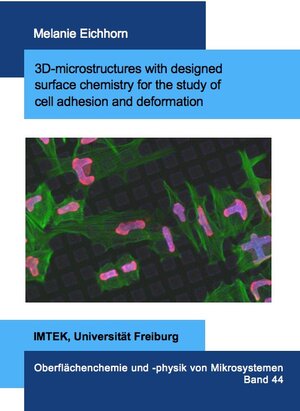
×
![Buchcover ISBN 9783843936958]()
3D-microstructures with designed surface chemistry for the study of cell adhesion and deformation
von Melanie EichhornThe use of artificial materials for medical applications requires a deep understanding and good control of cell adhesion to synthetic surfaces. It is well established that cellular adhesion is the result of a complex interplay between surface chemistry, topology and mechanical properties. In this work, we generate surfaces carrying polymeric microstructures in the dimension of cell organelles. The microstructures consist of a typical rubber material and are generated through a combination of microreplication and photochemical crosslinking. To achieve the crosslinking of the polymers photoactive benzophenone units are incorporated into the polymer through copolymerization and upon short UV-exposure the copolymers crosslink through C, H insertion reaction. The obtained microstructures are then further locally modified with cell adhesive and cell repellent polymers by a combination of microcontact printing and photochemistry, so that the surface chemistry is controlled at a level much smaller than that of a cell. Onto these surfaces cells are seeded which are known to be highly deformable and the deformation of the cells by the attractive and repulsive surfaces is studied.
The aim is to understand the mechanisms that influence adhesion and morphology of cancer cells and their nuclei, when seeded on micro-structured, partially-coated surfaces. Limits of cell adhesion and nucleus deformation are investigated as well as the mechanism behind the cell nucleus deformation. The results show that posts with variable surface chemistry are ideal candidates to answer biological questions concerning cellular adhesion.
The aim is to understand the mechanisms that influence adhesion and morphology of cancer cells and their nuclei, when seeded on micro-structured, partially-coated surfaces. Limits of cell adhesion and nucleus deformation are investigated as well as the mechanism behind the cell nucleus deformation. The results show that posts with variable surface chemistry are ideal candidates to answer biological questions concerning cellular adhesion.


